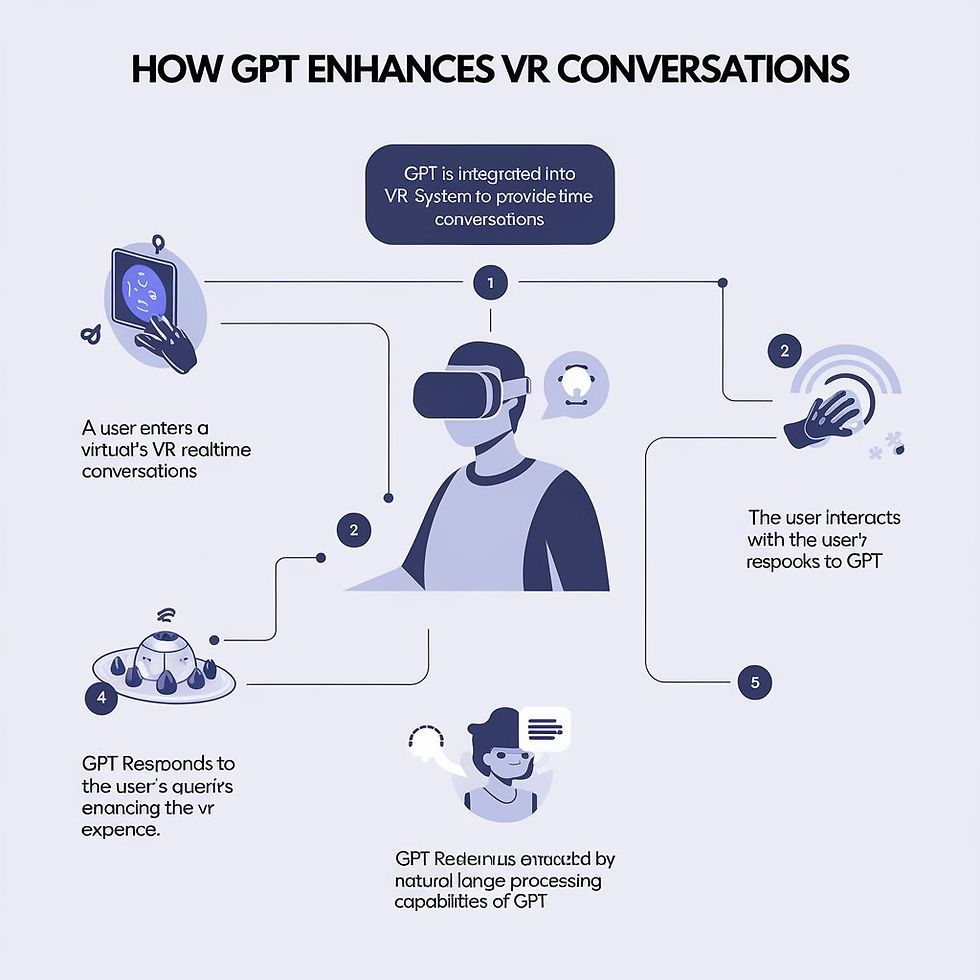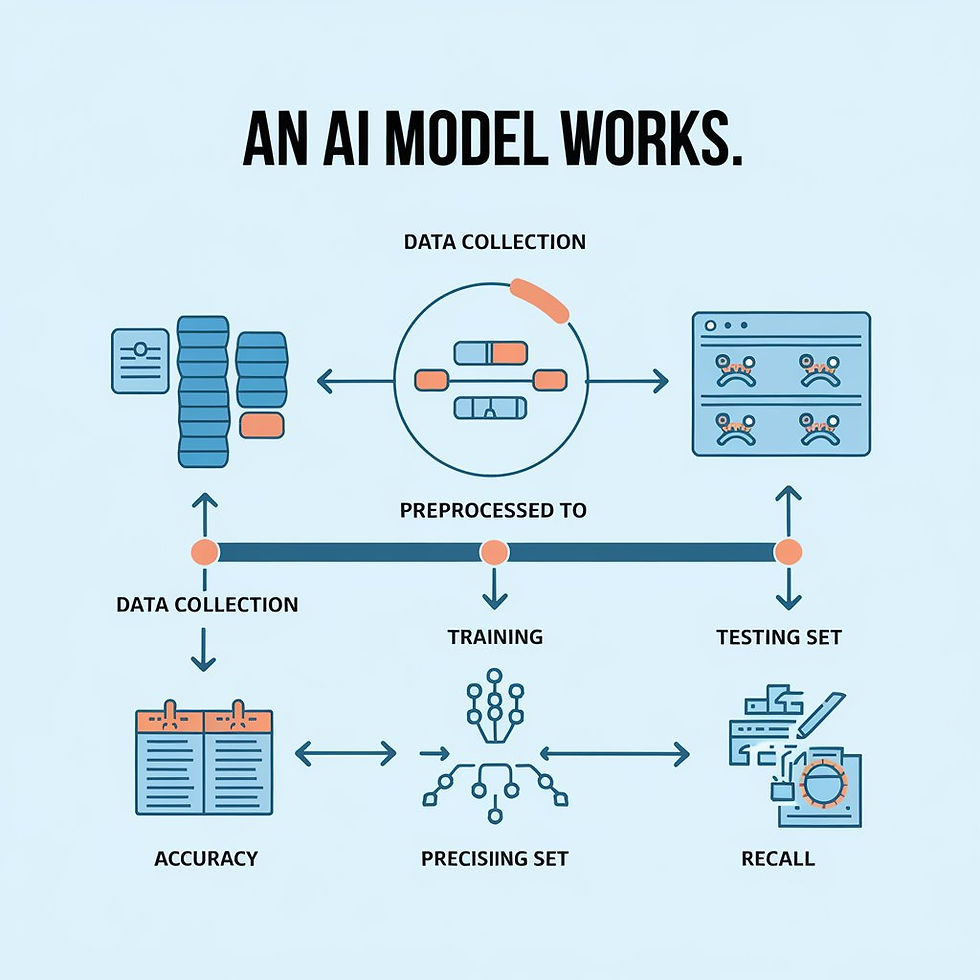How GPT Enhances Conversational AI in Virtual Reality
- Madhuri Pagale
- Mar 17
- 6 min read
Updated: Mar 25
- Eshal Shaikh (123B1E123), Shantanu Neve (123B1E148) , Parth Khairnar (123B1E151)
Introduction
Artificial Intelligence (AI) transforms how humans interact with machines, making digital experiences more natural and engaging. Among the most impactful AI technologies are Generative AI and Conversational AI. When combined with Virtual Reality (VR), these technologies create immersive and intelligent environments that feel realistic and responsive.
Generative AI models like GPT (Generative Pre-trained Transformer) have brought a new level of sophistication to Conversational AI. In VR, GPT can power realistic, dynamic interactions with virtual characters, adapt to user behavior, and generate real-time personalized narratives.
This guide explores how GPT enhances Conversational AI within VR, focusing on:
How GPT improves realism and engagement in VR interactions
The benefits of personalization, multilingual support, and dynamic storytelling
A complete, modular implementation using PyTorch, Pandas, NumPy, and the Transformers library
What is Generative AI?
Generative AI refers to AI models designed to create new content such as text, images, music, and even code. These models are trained on large datasets and use deep learning techniques to generate outputs that are realistic and contextually appropriate.
Example:
GPT-4, a state-of-the-art language model, can generate human-like text based on input prompts.
In VR, generative AI can create dynamic character dialogue and real-time story progression.
What is Conversational AI?
Conversational AI enables machines to understand and respond to human language through natural language processing (NLP), speech recognition, and machine learning.
Example:
Virtual assistants like Siri and Alexa are powered by Conversational AI to answer questions and complete tasks.
In VR, Conversational AI allows non-player characters (NPCs) to engage in unscripted, context-aware conversations with players.
Generative AI vs. Conversational AI
Aspect | Generative AI | Conversational AI |
Purpose | Creating new content (text, images, etc.) | Interactive dialogue in real-time |
Goal | Produce human-like outputs based on patterns in data | Understand and respond to user input naturally |
Example | AI-generated dialogue for a game character | AI-powered NPC answering player questions |
How GPT Fits | Generates realistic dialogue and dynamic storylines | Enhances NPCs’ ability to respond dynamically |
What is GPT?
GPT (Generative Pre-trained Transformer) is a deep learning-based language model developed by OpenAI. It is built on the Transformer architecture, which allows it to process large volumes of text data efficiently and generate human-like responses.
Key Capabilities of GPT:
Generates realistic and human-like responses
Adapts to the context of conversations
Supports multiple languages
Responds to user input in real-time.
What is Virtual Reality (VR)?
Virtual Reality is a computer-generated, immersive 3D environment where users can interact with objects and characters in real time. VR is used in various fields, including:
Gaming – Open-world exploration and player interactions
Healthcare – Surgery simulations and mental health therapy
Education – Virtual classrooms and learning environments
Business – Virtual meetings and product demonstrations.
How GPT Enhances Conversational AI in VR
Integrating GPT into VR-based Conversational AI brings a new level of realism and engagement by allowing for natural, unscripted dialogue and adaptive interactions.
1. Enhancing Realism in Virtual Interactions
Traditional VR interactions rely on pre-recorded scripts, making conversations repetitive and limited. GPT allows AI characters to respond in real time based on player input, creating more natural interactions.
Example: In a VR role-playing game, a player could ask an NPC about the game’s history, and GPT would generate a unique response based on the game’s lore.
2. Personalization and Adaptive Conversations
GPT can tailor conversations to individual users based on their behavior, preferences, and past interactions.
Example: In a VR educational environment, a GPT-powered tutor could adjust its teaching style based on the user’s strengths and weaknesses.
3. Multilingual and Cross-Cultural Communication
GPT’s multilingual capabilities enable seamless communication between users from different linguistic backgrounds.
Example: In a VR business meeting, GPT could provide real-time translation, allowing participants to speak in their native languages.
4. Dynamic Storytelling and Interactive Worlds
GPT can create adaptive storylines, changing the narrative based on player actions and choices.
Example: In an open-world VR game, GPT could generate new quests and character arcs based on the player’s decisions.
5. Voice Assistance and Speech Recognition in VR
Integrating GPT with speech recognition allows for hands-free interaction in VR.
Example: In a VR smart home, a user could say, "Turn off the lights," and GPT would understand and execute the command.
6. Improved Training and Skill Development in VR
GPT enhances training simulations by providing real-time feedback and dynamic scenarios.
Example: In a medical training program, GPT-powered virtual patients could respond differently based on the trainee’s approach.
7. AI-Powered Virtual Customer Support and Assistants
Businesses can use GPT-based virtual assistants to provide customer support in VR environments.
Example: In a VR shopping mall, GPT could help users find stores, recommend products, and answer questions.
8. Accessibility and Inclusion in VR
GPT can improve accessibility by offering text-to-speech and speech-to-text features.
Example: A visually impaired user could receive real-time, voice-guided navigation in a VR environment.
9. Seamless AI-Powered Collaboration in Virtual Workspaces
GPT can facilitate teamwork in VR by assisting with scheduling, note-taking, and brainstorming.
Example: In a virtual meeting, GPT could summarize discussions and suggest next steps.
10. Reducing Developer Effort and Automating Content Creation
GPT can automate dialogue creation and narrative design, reducing the workload for developers.
Example: A game developer could use GPT to generate NPC dialogue and story events automatically.

Implementation
A modular code structure ensures flexibility and scalability when implementing GPT-powered Conversational AI in VR.
Here's a link to the codebase: https://github.com/Shan-N/convoGPT.git
1. Dataset Loader (dataset_loader.py)
Handles loading and preprocessing of conversation data using Pandas and NumPy.Code Overview:
· Loads dataset
· Tokenizes and encodes text
· Prepares data for model training
class ChatDataset(Dataset):
def __init__(self, file_path, tokenizer, max_length=512):
with open(file_path, "r", encoding="utf-8") as f:
raw_data = json.load(f)
data = raw_data.get("data", [])
self.data = []
for entry in data:
if isinstance(entry, list):
for convo in entry:
if isinstance(convo, dict):
customer = convo.get("Customer", "")
salesman = convo.get("Salesman", "")
if customer and salesman:
self.data.append(f"Customer: {customer} | Salesman: {salesman}")
self.tokenizer = tokenizer
self.max_length = max_length
def __len__(self):
return len(self.data)
def __getitem__(self, idx):
text = self.data[idx]
encoding = self.tokenizer(
text,
return_tensors="pt",
padding="max_length",
max_length=self.max_length,
truncation=True
)
input_ids = encoding["input_ids"].squeeze(0)
attention_mask = encoding["attention_mask"].squeeze(0)
return {
"input_ids": input_ids,
"attention_mask": attention_mask,
"labels": input_ids.clone()
}
def get_dataloader(file_path, tokenizer, batch_size=8):
dataset = ChatDataset(file_path, tokenizer)
return DataLoader(dataset, batch_size=batch_size, shuffle=True)
if __name__ == "__main__":
tokenizer = AutoTokenizer.from_pretrained("gpt2")
tokenizer.pad_token = tokenizer.eos_token
dataloader = get_dataloader("data/raw/dataset.json", tokenizer)
for batch in dataloader:
print(batch["input_ids"].shape)2. Transformer Model (transformer.py)
Defines a custom GPT model using the Transformers library.Code Overview:
· Loads a GPT-2 model
· Fine-tunes for conversational output
class TransformerChatbot(GPT2LMHeadModel):
def __init__(self, config):
super().__init__(config)
def forward(self, input_ids, attention_mask=None, labels=None):
return super().forward(input_ids=input_ids, attention_mask=attention_mask, labels=labels)
3. Trainer (trainer.py)
Handles the training loop using PyTorch.
Code Overview:
· Uses gradient accumulation for efficient training
· Tracks loss over multiple epochs
· Saves trained model for deployment
tokenizer = AutoTokenizer.from_pretrained("distilgpt2")
tokenizer.pad_token = tokenizer.eos_token
dataloader = get_dataloader("data/raw/dataset.json", tokenizer, batch_size=2)
device = torch.device("cuda" if torch.cuda.is_available() else "cpu")
model = AutoModelForCausalLM.from_pretrained("distilgpt2").to(device)
optimizer = AdamW(model.parameters(), lr=3e-5)
loss_fn = nn.CrossEntropyLoss(ignore_index=tokenizer.pad_token_id)
epochs = 3
gradient_accumulation_steps = 4
model.train()
for epoch in range(epochs):
total_loss = 0.0
for step, batch in enumerate(dataloader):
input_ids = batch["input_ids"].to(device)
attention_mask = batch["attention_mask"].to(device)
labels = batch["labels"].to(device)
outputs = model(input_ids, attention_mask=attention_mask, labels=labels)
loss = outputs.loss / gradient_accumulation_steps
total_loss += loss.item()
loss.backward()
if (step + 1) % gradient_accumulation_steps == 0:
optimizer.step()
optimizer.zero_grad()
avg_loss = total_loss / len(dataloader)
print(f"Epoch {epoch + 1}/{epochs}, Loss: {avg_loss:.4f}")
torch.save(model.state_dict(), "models/chatbot_model.pth")4. Interface (interface.py)
Generates dynamic responses to user input using the trained model.
Code Overview:
Loads the model and tokenizer
Processes user input
Generates and outputs real-time responses
device = torch.device("cuda" if torch.cuda.is_available() else "cpu")
config = AutoConfig.from_pretrained("gpt2")
model = TransformerChatbot(config).to(device)
model.load_state_dict(torch.load("models/chatbot_model.pth"), strict=False)
model.eval()
tokenizer = AutoTokenizer.from_pretrained("distilgpt2")
if tokenizer.pad_token is None:
tokenizer.pad_token = tokenizer.eos_token
def generate_response(input_text):
inputs = tokenizer(input_text, return_tensors="pt", padding=True, truncation=True).to(device)
with torch.no_grad():
output = model.generate(
**inputs,
max_length=100,
temperature=0.8,
top_k=50,
top_p=0.9,
repetition_penalty=1.2,
do_sample=True
)
predicted_text = tokenizer.decode(output[0], skip_special_tokens=True)
return predicted_text
if __name__ == "__main__":
print("Chatbot is ready! Type 'quit' to exit.")
while True:
user_input = input("You: ")
if user_input.lower() == 'quit':
break
response = generate_response(user_input)
print(f"Bot: {response}")
Advantages of GPT in VR Conversations
Advantage | Description |
Realism | Dynamic, unscripted conversations |
Personalization | Adaptive, user-specific responses |
Multilingual Support | Real-time translation |
Dynamic Storytelling | Evolving game worlds and narratives |
FAQs
How does GPT enhance VR experiences?
GPT dynamically generates dialogue, NPC responses, and adaptive storytelling, making VR interactions more natural and personalized.
What are real-world applications of GPT in VR?
Applications include VR gaming with interactive NPCs, virtual customer support, healthcare simulations, and personalized learning in virtual classrooms.
How does GPT handle multilingual communication?
GPT's multilingual features allow real-time translation, enabling seamless cross-language communication in VR environments.
Conclusion
GPT is revolutionizing Conversational AI in VR by making virtual environments more realistic, interactive, and personalized. Its ability to generate dynamic dialogue and adapt to user input creates more engaging and immersive VR experiences. As GPT models continue to evolve, the potential for AI-powered VR interactions will only expand, unlocking new possibilities for gaming, training, business, and beyond.
References
Integrating GPT in VR Escape Rooms
ChatGPT for Immersive VR Experiences
AI Integration in VR by Glimpse Group
VR-GPT: Visual Language Model
LLM-Powered Avatars in VR Study


Insane Implementation
Informative Video
Insightful and innovative work 👏 👍🏻
Sheeer 🦁
Good